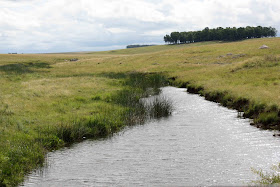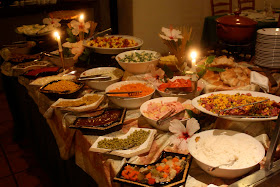
Horses running through the rain at the estancia.
After another night’s sleep totaling, at most, maybe two hours, I woke up at 4:45, grabbed a shower, and got a taxi to the airport. Things were moving so slowly there that by the time I got to my gate I didn’t have time for breakfast. I was given a ham and cheese sandwich on the plane, and at 10:50 a.m. I found myself touching down in Montevideo. The airport there was small but very clean and shiny, and I could have been in the U.S. with the lone food choices of McDonald’s and McCafé.
I decided to check with the taxi service at the airport to see how much it would cost to get a ride to Cerro Colorado, which is supposed to be about 100 miles from Montevideo. After being told it would cost $325, but that I could get a $50 discount, I opted for the local bus, which only cost $8.75. I still had to get a taxi to the bus terminal, and that trip alone cost me $35. But the driver was great – very talkative – and he was telling me all about the history of Uruguayan futbol. He said that two of the airport taxi drivers used to play soccer professionally in Italy, and he was quite proud that Uruguay had won the World Cup twice. He also recommended Uruguayan Tannat, a red wine that can only be grown in Uruguay and southwestern France. He convinced me to try a glass of it tonight, as a matter fact. In any case, in thirty minutes he had me at the terminal and we said goodbye.
The Tres Cruces Terminal is part bus station, part food court, part shopping mall. Since I really hadn’t eaten anything of substance, I chose a nice-looking restaurant called La Mastaza.

Nice place for a bus terminal.
And since La Mastaza was on the menu, I ordered a dish by the same name along with a bottled water. First of all, I was surprised by the price. I didn’t think food in Uruguay could be as expensive as in Chile, and it probably isn’t, but for a lunch item I still ended up paying over $10. I soon discovered why. I was given so much food they had to serve it to me on separate plates.

Heart attack special.
It was prime heart attack material, too. A pretty decent piece of beef layered with ham, god knows how much mozzarella cheese, and thick strips of bacon. There were also French fries, potato and carrot salad (drowning in mayo), and a mixed salad (flooded on the bottom with mayo). I was stunned when the waitress set it down. I really didn’t want all of this sitting in my stomach for a four-hour bus ride into Uruguay’s interior. But I did the best I could, which meant leaving half uneaten, unfortunately. I was totally stuffed. Again – this is the problem with ordering from a menu I basically can’t read.
A couple hours later my bus arrived, and I was none the worse for wear.

That's my bus sitting in parking space #28.
I hopped on, claimed my seat, and watched the aisles fill up with standing room only passengers. A lot of other people were also heading into Uruguay’s interior, apparently. The view of the Uruguayan countryside was a nice change from the mostly clean, modern, and affluent Chilean countryside. A lot of what I saw reminded me of the Vietnamese countryside –the colors of buildings, farmers’ ramshackle homes, the poor living conditions of spread-out villages, the palm-studded landscape, chickens running about yards and street shoulders, the long dirt lanes running perpendicular to the highway. But it was also entirely different. When villages became towns, most of the shop owners seemed to be sitting out on the curbs, or on benches in the shade of their store roofs, watching things slowly go by. The bus stopped at least ten times to deliver items to different places – almost like a postal service, it seemed. And the bus never announced where the stops actually were, and I got a bit lucky at Cerro Colorado, as I happened to ask a gun-toting policeman – I’m not sure if he was there as security or was a passenger – in the seat in front of me where we were, and he told me it was where I wanted to get off. So I did. There was a taxi waiting for me at the small gas station – there was nothing “bus station” about it – and he took me flying down a long dirt road for 11 km until we came to the estancia, or old Uruguayan ranch, where I’ll be staying for two nights. The 11 km drive was pretty spectacular, too.




The estancia is extremely impressive.

Front of main building of estancia.

Looking toward the road that brought me here.
Unfortunately, no one here speaks English as far as I can tell, and there’s no information about this estancia for me to share here. Still, I can say that the complex is pretty massive, at least to me – granted, it’s not Texas-sized – and has quite a number of horses…and dogs…and a cat…the latter two species of which immediately befriended me.

"Pet me now..."
After checking in – my room is massive, too; the bathroom alone could easily fit a car and a couple of motorcycles – I wandered around the immediate area to see what was here.
Actually, I’m not really sure what is here, although I counted two outdoor pools, one indoor pool, at least one restaurant, at least two libraries, at least two television rooms, and least two game rooms, a silo, a cistern, at least two stables, rolling hills and fields, and tons and birds (parakeets especially) and flies.

This pool was filled with leaves and sticks after the storm.

A silo, perhaps?

The corridor to my room.

The short dog in the foreground was jealous of the bigger dog, who could reach as high as the fountain and drink its turbid water.

They have a bocce field. And apparently people who play...
Someone at reception came out to inform me that dinner started at 9 p.m., but that afternoon tea was already in progress. So I headed over there and saw that there were sweets all over the place.

The dining area.

Tea time. It might as well be called "sugar time."
I controlled myself pretty well, I have to say, and only had a couple small items. (I still wasn’t hungry after lunch.) By the time afternoon tea was over, it was pouring outside, and I was trapped with a book and my camera in the dining room. Not only me, but also that cat that I mentioned above. In order to stop its constant mewing I was forced to pet the darned thing, and later when I sat down on a chair it jumped into my lap and donated lots of hair and dander to my pants. The rain continued in fits and starts for the rest of the day, which didn’t bother me much. The setting of the estancia made it seem very beautiful.

Horse pen shortly before the rain started coming down.

A field full of horses, which I photographed before tea time.
At nine o’clock I headed over to a different building for dinner.

This is only part of the spread for dinner. And I didn't take a photo of the dessert options, either.
I was fine eating alone – I’ve been doing it for the last seven weeks, after all – and the woman managing the dining room was very kind in helping explain to me what Tannat is and getting me a bottle of water. I got a plate from a table in the middle of the room and filled it with various interesting items.

A mish-mash of goodies.
But it was when I decided to have a look at the dessert table – well, did you think I wouldn’t? – that something happened which never would have happened in Chile: a young Uruguayan man introduced himself to me, and despite knowing that my Spanish was poor he invited me to join his table for conversation. And we had a great conversation! It was a really nice gesture, but in fact it was more than a gesture. He and his friends were truly curious about my life and asked lots of questions about the United States, and when I asked questions in return about Uruguay, they tried their hardest to help me understand. One thing I found interesting was their comment that young people have a really bleak future in Uruguay. The education system here is actually quite good, but when people graduate from college there just aren’t any good jobs in the country that can absorb them. Uruguay imports so much from China, and exports so little back – just beef and leather, basically – that their system of imports actually harms the prospects of young people. They said that these days most young people try to go abroad – to Spain, most of all, and then to Argentina – and then if they manage to do well they send money back to their families here. This is a story one hears in many countries, of course. In any case, having a long conversation with them over dessert was a nice way to end the day.
No comments:
Post a Comment